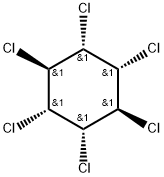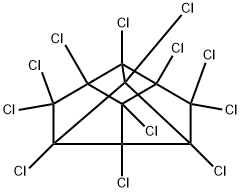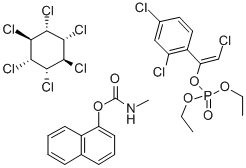LINDANE
Synonym(s):Lindane;γ-BHC;gamma-hexachlorocyclohexane;1α,2α,3β,4α,5α,6β-Hexachlorocyclohexane;γ-1,2,3,4,5,6-Hexachlorocyclohexane
- CAS NO.:58-89-9
- Empirical Formula: C6H6Cl6
- Molecular Weight: 290.81
- MDL number: MFCD00135947
- EINECS: 200-401-2
- SAFETY DATA SHEET (SDS)
- Update Date: 2024-03-14 15:18:26

What is LINDANE?
Absorption
Lindane is absorbed significantly through the skin. A mean peak blood concentration of 28 nanograms per mL occurred in infants and children 6 hours after total body application of lindane lotion for scabies.
Toxicity
Lindane is a moderately toxic compound via oral exposure, with a reported oral LD50 of 88 to 190 mg/kg in rats. Gamma-HCH (which constitutes 99% of lindane) is generally considered to be the most acutely toxic of the isomers following single administration. It is moderately toxic via the dermal route as well, with reported dermal LD50 values of 500 to 1000 mg/kg in rats, 300 mg/kg in mice, 400 mg/kg in guinea pigs, and 300 mg/kg in rabbits. Acute exposure to lindane may lead to central nervous system stimulation (usually developing within 1 hour), mental/motor impairment, excitation, clonic (intermittent) and tonic (continuous) convulsion. Other adverse reactions include central nervous system toxicity, as well as skin and gastrointestinal changes.
Description
Lindane is one of eight different hexachlorocyclohexane (HCH), [58-89-9], C6H6Cl6, isomers and its Chemical Abstract name is 1α, 2α,3β,4α,5α,6β- hexachlorocyclohexane 58-89-9 (γ-HCH or γ -BHC, benzene hexachloride) (80). Commercial products containing lindane are marketed as either a mixture of isomers or as the pure γ -BHC isomer. Not unexpectedly, lindane is a highly stable lipophilic compound and it has been used extensively worldwide as an insecticide. In contrast, hexachloropentadiene, [77-47-4], C5Cl6, is an extremely reactive industrial intermediate used as a chemical intermediate in the synthesis of a broad range of cyclodiene-derived pesticides, which include endosulfan, endrin, heptachlor, and several different organohalogen flame retardants (81).
The Uses of LINDANE
The only identified uses for hexachlorocyclohexane-containing products are based on the insecticidal activity of the γ isomer (lindane), which is considered to be the only insecticidally effective component (Extoxnet 1996). Lindane or technical-grade hexachlorocyclohexane containing the γ isomer is used primarily as an insecticide in the treatment of wood and wooden structures, seed grains, and livestock (ATSDR 2005, HSDB 2009). Other major uses are as an insecticide for several dozen fruit and vegetable crops, in baits and seed treatments for rodent control, and for treatment of scabies (mites) and lice. It is approved by the U.S. Food and Drug Administration foruse in three products for the treatment of lice and scabies (one lotionand two shampoos) (FDA 2009). Agricultural and pesticide uses accounted for about 270,000 kg (594,000 lb) of lindane and 450,000 kg (1 million pounds) of technical-grade hexachlorocyclohexane in 1974;the remaining uses were industrial or pharmaceutical (IARC 1979).
Indications
For the treatment of patients infested with Sarcoptes scabiei or pediculosis capitis who have either failed to respond to adequate doses, or are intolerant of other approved therapies.
Background
An organochlorine insecticide that has been used as a pediculicide and a scabicide. Lindane has been banned in California, United Kingdom, Australia, and many western countries due to concerns about neurotoxicity and adverse effects on the environment. In Canada, Lindane is not recommmended as a first-line therapy due to reports of resistance, neurotoxicity, and bone marrow suppression, but has been approved by the FDA as a second-line therapy for topical treatment of pediculosis capitis (head lice), pediculosis pubis (pubic lice), or scabies in patients greater than two years of age who cannot tolerate or have failed first-line treatment. Lindane is still allowed for pharmaceutical use until 2015.
Pharmacokinetics
Scabies is a common, highly pruritic infestation of the skin caused by Sarcoptes scabiei (lice). It is a very contagious condition with specific lesions, such as burrows, and nonspecific lesions, such as papules, vesicles and excoriations. The typical areas of the body it affects are finger webs, scalp (hair), wrists, axillary folds, abdomen, buttocks, inframammary folds and genitalia (males). It is characterized by intense night-time itching. Scabies is spread through close personal contact (relatives, sexual partners, schoolchildren, chronically ill patients and crowded communities). Scabies infestations and the corresponding symptoms can be eliminated by killing the scabies with topical insecticides or scabicides. Lindane is a scabicide that is essentially an organochloride insecticide.
Metabolism
Primarily hepatic through dechlorination leading to 2-chlorophenol, 0-chlorophenol, chlorocyclohexane, chlorocyclohexanol.
Properties of LINDANE
| Melting point: | 113-115 °C(lit.) |
| Boiling point: | 373.64°C (rough estimate) |
| Density | 1.7152 (rough estimate) |
| Flash point: | 11 °C |
| storage temp. | 0-6°C |
| solubility | H2O: insoluble0.01g/L (practically) |
| form | neat |
| Water Solubility | 7.3 mg l-1 (25 °C) |
Safety information for LINDANE
| Signal word | Danger |
| Pictogram(s) |
 Skull and Crossbones Acute Toxicity GHS06  Health Hazard GHS08  Environment GHS09 |
| GHS Hazard Statements |
H301:Acute toxicity,oral H362:Reproductive toxicity, effects on or via lactation H373:Specific target organ toxicity, repeated exposure H410:Hazardous to the aquatic environment, long-term hazard |
| Precautionary Statement Codes |
P260:Do not breathe dust/fume/gas/mist/vapours/spray. P263:Avoid contact during pregnancy/while nursing. P273:Avoid release to the environment. P280:Wear protective gloves/protective clothing/eye protection/face protection. P301+P310:IF SWALLOWED: Immediately call a POISON CENTER or doctor/physician. |
Computed Descriptors for LINDANE
Abamectin manufacturer
New Products
3-N-BOC-(S)-AMINO BUTYRONITRILE 4-Piperidinopiperidine 2-Methyl-4-nitrobenzoic acid 2-(4-bromophenyl)-2-methylpropanoic acid 4-Acetyl-2-methylbenzoicacid Acetyl-meldrum's acid Ethyl-4-Pyrazole carboxylate 2,6 Di acetylpyridine 2,6-Pyridinedimethanol 5,7-Dichloro-3H-Imidazo[4,5-B]Pyridine 5-Bromo-2-Methoxy-4-Methyl-3-Nitropyridine 2-Fluoro-5-Iodopyridine 2-Fluoro-5-Methylpyridine 2-Chloro-3-Bromo-5-Amiopyridine METHYL-4-(BUTYRYLAMINO)3-METHYL-5-NITROBENZOATE TRANS-CYCLOBUTANE-1,2- DICARBOXYLIC ACID 5-Nitro indazole R-(-)-5-(2-AMINO-PROPYL)-2-METHOXY-BENZENESULFONAMIDE 1,3-cyclohexanedione 4-Aminophenaethylalchol 3-NITRO-5-ACETYL IMINODIBENZYL (S)-(+)-4-BENZYL-2-OXAZOLIDINONE 4-FLUORO PHENYL MAGNESIUM BROMIDE 1.0 M IN THF 1-HYDROXY-4-METHYL6-(2,4,4-TRI METHYL PHENYL)-2-PYRIDONE MONO ETHANOL AMINE(PIROCTONE OLAMINE)Related products of tetrahydrofuran








You may like
-
 58-89-9 Lindane 98%View Details
58-89-9 Lindane 98%View Details
58-89-9 -
 58-89-9 98%View Details
58-89-9 98%View Details
58-89-9 -
 Lindane 98%View Details
Lindane 98%View Details
58-89-9 -
 68915-31-1 99%View Details
68915-31-1 99%View Details
68915-31-1 -
 Azadirachtin 11141-17-6 99%View Details
Azadirachtin 11141-17-6 99%View Details
11141-17-6 -
 Geraniol 99%View Details
Geraniol 99%View Details
106-24-1 -
 BENZALKONIUM CHLORIDE BKC 99%View Details
BENZALKONIUM CHLORIDE BKC 99%View Details
8001-54-5 -
 Amrit Neem 11141-17-6 99%View Details
Amrit Neem 11141-17-6 99%View Details
11141-17-6